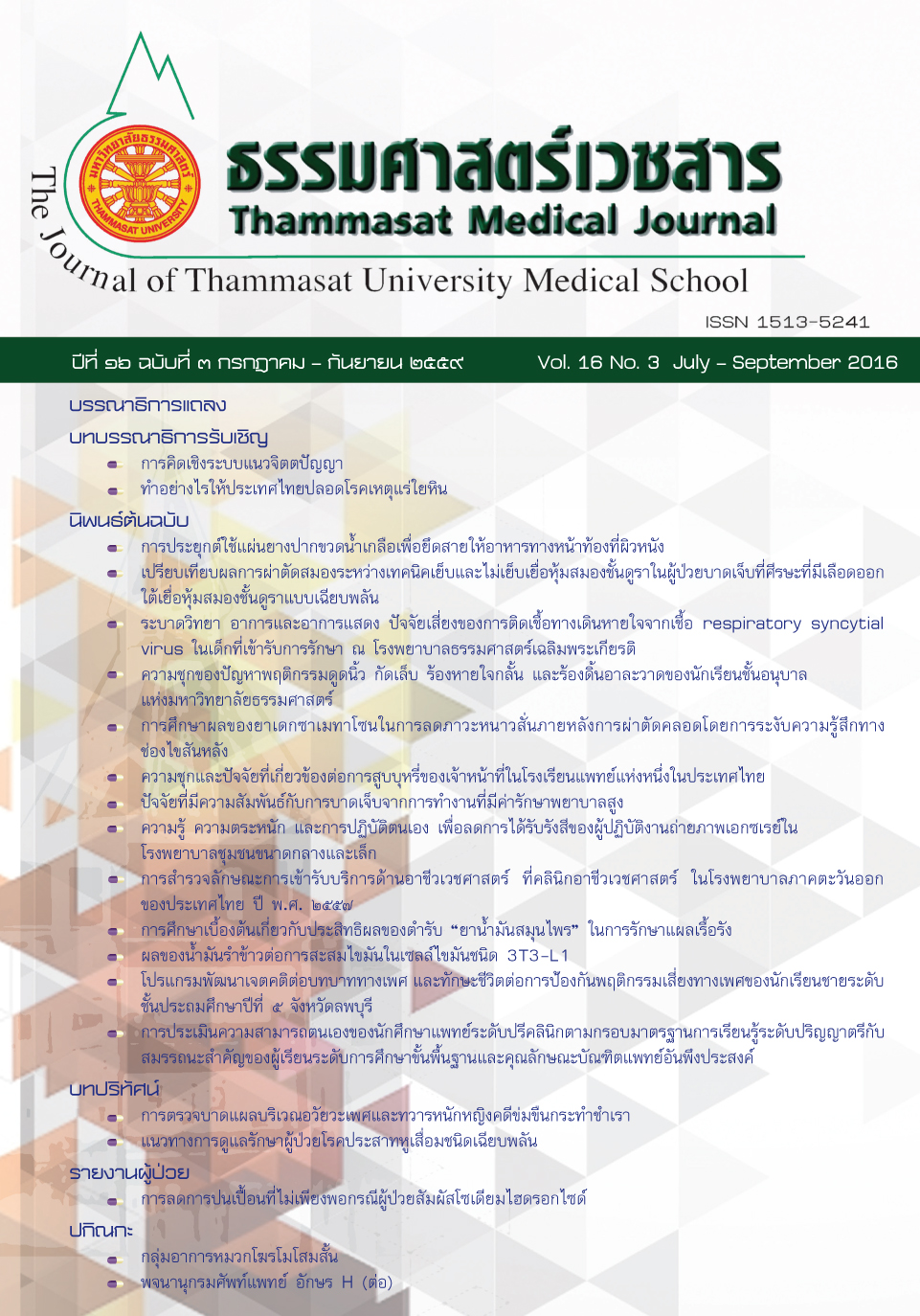Clinical use of rubber disc cap from the intravenous fluid bottle as the pediatric gastrostomy tube holder
คำสำคัญ:
Gastrostomy tube replacement, Foley’s catheter, Complication, Rubber disc holder, การเปลี่ยนสายให้อาหารทางหน้าท้อง, สายสวนปัสสาวะ, ภาวะแทรกซ้อน, แผ่นยึดที่ผิวหนังบทคัดย่อ
Introduction: To study incidence of dislodgement of gastrostomy tube using Foley’s catheters with rubber disc cap from intravenous fluid bottle as the gastrostomy tube holder.
Method: This was a report of a descriptive retrospective study that included children (aged 0-15 years), who had their gastrostomy tubes replaced by using Foley’s catheters and rubber disc holders during 1 June 2012 - 30 December 2013.
Result: There were 99 catheter replacements in 16 children which used Foley’s catheters and rubber disc holders. 87 catheters were replaced every 8 weeks as scheduled, and the others were emergency events. The most frequent cause of the emergency replacement was the catheter displacement from ruptured balloon, comprising 10% of all events. No events of latex allergy or dislodgement were noted. The average length that catheter sliding in was 0.3 ± 0.2 centimeters.
Discussion and Conclusion: The additional rubber disk holder for gastrostomy tube replacement using Foley’s catheters instead of the commercial gastrostomy ones is a safe and convenient practice. Moreover, this procedure can reduce the dislodgement and granulation tissue formations dramatically. There is no event of latex allergy.
บทนำ: ศึกษาอุบัติการณ์การเลื่อนเข้าของสายให้อาหารทางหน้าท้องที่ใช้สายสวนปัสสาวะทดแทนร่วมกับการใช้แผ่นยางปากขวดน้ำเกลือเป็นตัวยึดสายให้อาหารที่ผิวหนัง
วิธีการศึกษา: เก็บข้อมูลย้อนหลังเชิงพรรณนา ผู้ป่วยเด็ก (๐ - ๑๕ ปี) ซึ่งได้รับการเปลี่ยนสายให้อาหารทางหน้าท้องโดยใช้สายสวนปัสสาวะที่โรงพยาบาลธรรมศาสตร์เฉลิมพระเกียรติ ในช่วงเวลา ๑ มิถุนายน พ.ศ. ๒๕๕๕ - ๓๐ ธันวาคม พ.ศ. ๒๕๕๖
ผลการศึกษา: มีการเปลี่ยนสายให้อาหารทางหน้าท้องโดยใช้สายสวนปัสสาวะรวม ๙๙ ครั้ง เป็นการเปลี่ยนตามกำหนดทุก ๘ สัปดาห์ ๘๗ ครั้ง และเปลี่ยนสายแบบฉุกเฉิน ๑๒ ครั้ง จากผู้ป่วย ๑๖ คน สาเหตุที่ทำให้ต้องเปลี่ยนสายแบบฉุกเฉินมากที่สุดคือจากการเลื่อนหลุดจากบอลลูนแตก ๑๐ ครั้ง คิดเป็นร้อยละ ๑๐ ของการเปลี่ยนสายทั้งหมด ไม่พบการเลื่อนเข้าของสาย และค่าเฉลี่ยการเปลี่ยนแปลงตำแหน่งความยาวของสายคือ ๐.๓ ± ๐.๒ เซนติเมตร ไม่พบการแพ้ยาง
วิจารณ์ และสรุปผลการศึกษา: การใช้แผ่นยางยึดตรึงสายสวนปัสสาวะกับผิวหนังเพื่อป้องการการเลื่อนเข้าของสายสวนปัสสาวะที่ใช้ทดแทนสายให้อาหารทางหน้าท้องเชิงพาณิชย์สามารถลดการเลื่อนเข้าของสายและการเกิดของเนื้อเยื่อแกรนูเลชันได้อย่างดีเยี่ยมและปลอดภัย ไม่พบภาวะแทรกซ้อนจากการแพ้ยาง



